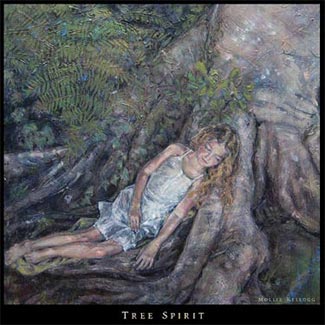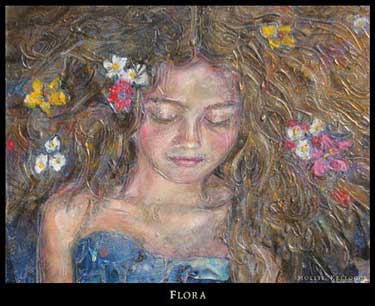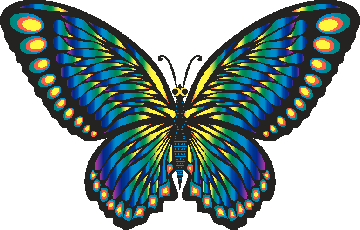Skullcap
Herbal Adventures with Susun S Weed
by Susun S. Weed
read other Herbal Adventures part 1, part 2 , part 3 , part 4
I promised to meet you deep in the woods during a summer thunderstorm. That's my favorite time to pick one of my favorite mints: mad dog weed, also known as skullcap. I always keep a bottle in my first-aid kit, just in case.  Here, you take the basket and scissors, I have the vodka; let's make some skullcap tincture.
Here, you take the basket and scissors, I have the vodka; let's make some skullcap tincture.
If you're going to come with me to hunt for skullcap (Scutellaria lateriflora), may I suggest you take off your shoes. Skullcap grows in wet places and the mud feels nice between your toes. No sense in searching for her until the nights are warm. I usually harvest skullcap in August here in the Catskills, when she is at the peak of her growth and flowering.
I'm blessed to have skullcap in my wet woods. She is somewhat rare, and difficult to find. She's very shy. And likes to hide. Most people who look for skullcap come away empty-handed. But if you don't find her, you will very likely find Lycopus, wolf mint, sometimes called mountain mint.
Where skullcap is sprawling and lanky, hardly trying to stand up, wolf mint is erect and short. Skullcap has blue-purple flowers, while wolf mint has little ruffs (whorls) of white flowers around the stem. Despite these differences, Lycopus is considered an excellent substitute for skullcap.
These mints need to be tinctured fresh. Drying skullcap or wolf mint evaporates most of the delicate components that make these plants so gently effective. So I use only the very freshest plant material. That's why we're taking the vodka to the skullcap. We're going to make our tincture in the woods. Even a short delay between harvesting and tincturing weakens the final product.
If you can't find skullcap, you may want to try growing her. She is fussy, and very demanding. Unlike most mints, she likes rich earth, but not too rich. She wants wet soil, but not too wet. And she likes dappled sunlight but not too shady, and not too sunny either, please.
Let's sing as we walk to the skullcap "swamp." Singing is my favorite form of prayer. And I want skullcap to hear us coming and welcome us. Aha! Here we are--feel the squishy warm mud underfoot?
See if you can find the skullcap among the life root (Senecio aureus) and forget-me-nots. Look not only for her blue-violet flowers but also for her strangely shaped seed pods. They are said to look like skulls, but you will have to use your imagination to see the resemblance. Perhaps she got her name from her ability to relieve headaches. Or because, if you take enough skullcap, your head droops like her flowers and you sleep.
Because there is so little skullcap, even where there seems to be a lot of it, and because drying it makes it nearly worthless as a medicinal plant in my estimation, I don't make tea or infusion with it. Remember that even if we harvested a pound of fresh skullcap, it would dry down to a mere four ounces. Instead, I preserve and maximize skullcap's properties by tincturing her. And since I use skullcap primarily for pain relief, it's great to have a fast-acting tincture.
I find a small dose (3-5 drops of fresh skullcap tincture) takes the edge off a simple tension headache in a few minutes. A larger dose (10-15 drops), taken three or four times at the beginning of a major headache, can often stop it from coming on or moderate its pain and length. A really large dose (a dropperful or 15-25 drops) will make you very sleepy.
 I once spilled my skullcap tincture while teaching at a college. Without thinking much, I scooped the spilled liquid into my mouth. Several hours later, driving home, I literally could not keep my eyes open. I had to pull off the road and take a nap!
I once spilled my skullcap tincture while teaching at a college. Without thinking much, I scooped the spilled liquid into my mouth. Several hours later, driving home, I literally could not keep my eyes open. I had to pull off the road and take a nap!
But you don't need to take skullcap tincture by the handful to get to sleep. As little as ten drops in a cup of warm milk (or hot chocolate) is quite effective. Lighting a candle, cuddle up in bed, drink your skullcap nightcap, and get ready for pleasant dreams.
People addicted to sleeping pills (and other addictive substances) find skullcap tincture an ally when they are ready to get off drugs. Make sure there's a glass of water with another dose of skullcap already in it next to your bed, in case you need it. Then blow out the candle, say your prayers, and good night.
Skullcap tincture relieves almost any pain, especially when the nerves are involved. Try skullcap when bothered by sciatica pain, neuralgia, toothache, eye twitches, or ringing in the ears.
Skullcap was a powerful ally for me when I sprained my wrist far from home on a camping trip. The pain was so intense I thought I wouldn't be able to sleep. But a dropperful of skullcap put me out. Every time the pain woke me--probably a dozen times that first night--I took another dropperful and went back to sleep almost instantly.
Skullcap works well with St. Joan's wort (discussed in a previous SageWoman). These friends, taken together, ease migraines, relax stiff muscles, and relieve pain throughout the body.
If I'm in a stressful situation, I take 1-2 drops of skullcap in the morning, right after I get up. It seems to strengthen my nervous system, and doesn't make me at all sleepy.
If you buy skullcap tincture, and it is made from dried plants, multiply my doses by ten to get the same effects.
Listen to that thunder roll across the mountains. They say it's Rip Van Winkle playing at nine pins with the wee folk. Time to head back to the house, where we can pull out the last two remedies in my first-aid kit. And we'd better move fast or more than our feet will be wet.
Question and Answer:
Dear Susun,
Thank you for your wonderful article on comfrey leaf in SageWoman. I ordered a pound of comfrey leaf from Frontier, assuming it would be the cultivated kind. But it was labeled Symphytum officinale. I spoke to someone there, but she didn't seem to understand my question, and said that even if it was the cultivated type they would still stand behind their warning of "external use only."
This spring I will plant comfrey so I won't have to rely on Frontier, but in the meantime, I would like to begin the infusion. Should I trust the label and assume it is the wild variety, or should I just go for it and hope that it has no toxins? By the way, your website is awesome.
Nicole
Dear Nicole;
I think the Frontier comfrey leaf is mislabeled. I think everybody's comfrey leaf is mislabeled. Symphytum officinale--a small plant with yellow flowers--is rarely grown in North America, and never sold, so far as I can determine. So, despite the label, what you have bought is most likely an S. uplandica cross.
I'm not surprised there's so much confusion. I was taught the comfrey in my garden was Symphytum officinale, and passed on that misinformation for many years. That's what all the books say. But when I got involved with the Henry Doubleday Research Foundation in England, I learned that I was wrong. And when I finally saw wild comfrey growing (in Germany), it was obviously different from the big pink-purple flowered plant in my garden--and every garden I've been in.
I did once see wild comfrey in a garden. I was called in to help them get rid of it; unfortunately, an impossible task.
So I sincerely believe that the comfrey leaf you bought from Frontier is uplandica, whether they know it or not. I buy the very some organic comfrey leaf from them. That's what I use during the summer when the apprentices, students, and I go through 3-5 gallons of infusion a day. During the winter, when I'm alone, I use my home-grown comfrey.
To maximize alantoin content, I harvest the flowering stalks of my comfrey: that's the stalk, leaves, and flowers. I store the dried herb whole, but take the time to cut it up as small as I have patience for when I brew it into nourishing herbal infusion.
If you want to play it safe, or if you sense that you shouldn't use the comfrey you bought, then you could add it to your compost (the worms love it). Instead of comfrey, you could use mullein infusions and linden infusions.
There are so many green blessings.
Susun

 CORRESPONDENCE COURSES
CORRESPONDENCE COURSES
with Susun Weed
FOUR COURSES: Green Witch, Green Allies, Spirit & Practice of the Wise Woman Tradition, and a new course ABC of Herbal Medicine. All are multi-cultural and are suitable for beginning, intermediate, or advanced students. Most of my students take 13-15 months to complete one course, but there is no time limit.
 Green Allies explores herbal medicine through direct experiences with plants, plant spirits (fairies, devas), and plant medicines. For those who want to deepen, rather than broaden, their knowledge of plants: a year's worth of investigation and experimentation with one plant ally.
Green Allies explores herbal medicine through direct experiences with plants, plant spirits (fairies, devas), and plant medicines. For those who want to deepen, rather than broaden, their knowledge of plants: a year's worth of investigation and experimentation with one plant ally.
Learn more about Green Allies Correspondence Course...
 Green Witch focuses on personal and spiritual development. You'll create rituals, prepare an herbal first-aid kit, encounter your Goddess archetype, discover the magic of your menstrual/menopausal changes, and develop wise woman ways of living and healing.
Green Witch focuses on personal and spiritual development. You'll create rituals, prepare an herbal first-aid kit, encounter your Goddess archetype, discover the magic of your menstrual/menopausal changes, and develop wise woman ways of living and healing.
Learn more about Green Witch Correspondence Course ...
 Spirit & Practice of the Wise Woman Tradition focuses on understanding, internalizing, and using the Three Traditions of Healing (Wise Woman, Heroic, and Scientific) and the Six Steps of Healing. Health-care practitioners find this course exceptionally helpful, but anyone who cares for the health of others (even family members) will benefit.
Spirit & Practice of the Wise Woman Tradition focuses on understanding, internalizing, and using the Three Traditions of Healing (Wise Woman, Heroic, and Scientific) and the Six Steps of Healing. Health-care practitioners find this course exceptionally helpful, but anyone who cares for the health of others (even family members) will benefit.
Learn more about Spirit & Practice Correspondence Course ..
 ABC Herbal Medicine This is a special course for the aspiring herbalist who would like to have me "by your side" teaching you how to identify, harvest, and buy 52 healing herbs. I'll "watch over your shoulder" as you make nourishing herbal infusions, tinctures, vinegars, oils, honeys, poultices, soups, and beauty aids.
ABC Herbal Medicine This is a special course for the aspiring herbalist who would like to have me "by your side" teaching you how to identify, harvest, and buy 52 healing herbs. I'll "watch over your shoulder" as you make nourishing herbal infusions, tinctures, vinegars, oils, honeys, poultices, soups, and beauty aids.
Learn more about ABC of Herbal Medicine...

Botany and Wildcrafting for Herbalists DVD
 Botany for Herbalists DVD
Botany for Herbalists DVD
Susun Weed takes you on a walk with her apprentices and her goats across her land at the Wise Woman Center. In this DVD she explains the Latin naming system devised by Swedish botanist Carl Linnaeus in the 1700's. Each herb has a family and a genus that it belongs to and a species that is its name. She explains the Tree of Life, flowering and non-flowering plants, and the reproductive cycle of flowering plants and herbs. She also teaches you about indentifying and harvesting herbs; and differentiates between annuals, biennials and perennials. As Susun says: “Weave yourself into the Wise Woman web. Join me in reclaiming herbal medicine as people’s medicine. Loving green blessings from me to you.”
Time: 1 hr, 12 min, 43 sec.
Produced in 2009 by HerbTV Studio
Price: $19.95
Order Botany for Herbalists DVD in our Bookshop

Introduction to Herbalism DVD
1 hour and 48 minute DVD packed with herbal wisdom
Matthew takes you out into the fields to see the herbs in their natural habitat and explain the magical wisdom of nature in giving the plants to us. He teaches the wisdom of our ancestors about the healing power of these plants that informs our use today.
Herbs covered: Bergamot, Boneset, Elder, Elecampane, Goldenrod, Lobelia, Mullein, Peach leaf, Peppermint, Plantain, Rose, Sumac, White pine, Wild cherry, Yarrow.
 Introduction to Herbalism DVD
Introduction to Herbalism DVD
1 hour and 48 minute DVD
Price: $19.95



 CORRESPONDENCE COURSES
CORRESPONDENCE COURSES 

